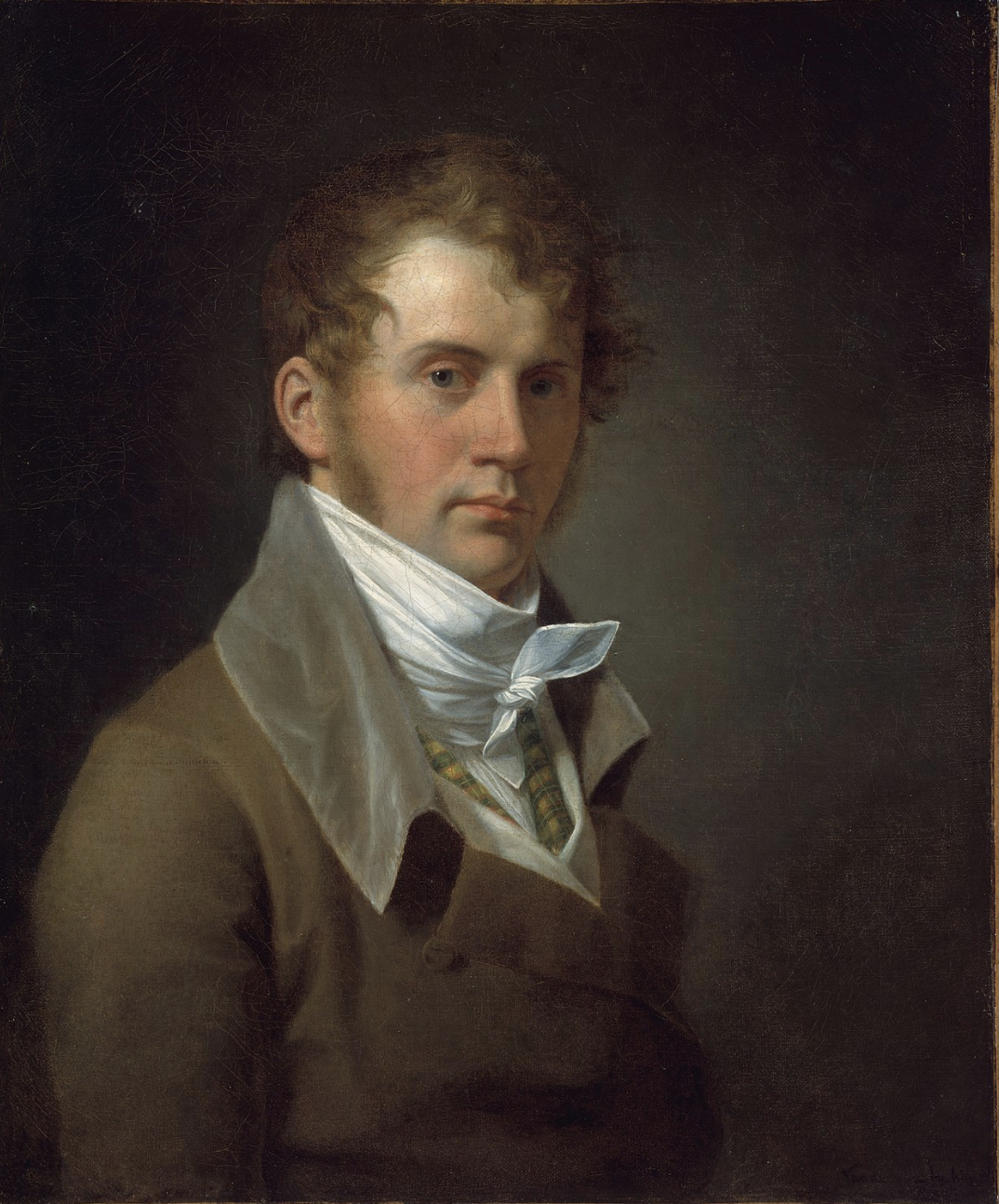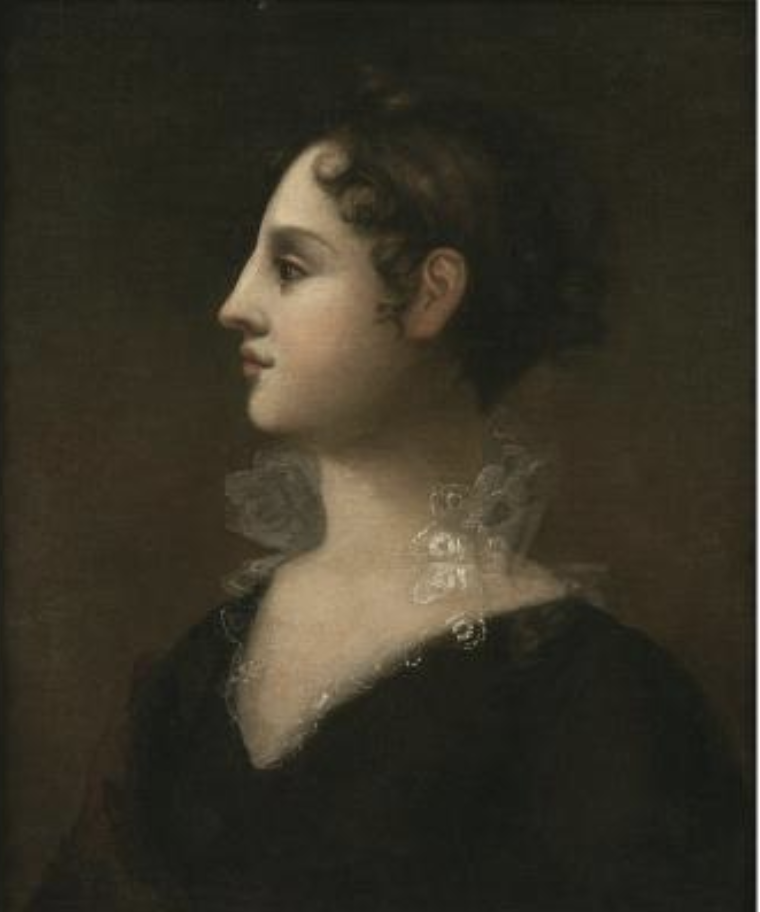Born into one of the most elite of New England families, Aaron Burr was determined to prove he was a gentleman of taste and intellectual refinement as well as an accomplished lawyer and savvy politician. He received the latest books from London booksellers for his personal library, his dinners featured European-inspired menus, and his home was filled with beautiful furnishings. Even the trees and plants in his gardens were carefully chosen and cultivated to reflect his interest in botany and horticulture. He had portfolios of engraved prints to peruse, and one of the prizes of his personal art collection was a portrait of the feminist writer and philosopher Mary Wollstonecroft.
Burr went a step further than most of his American contemporaries: he became the patron of American artist John Vanderlyn (1775-1852). Born in Kingston, NY, the teenaged Vanderlyn was continuing his artistic training by working in the studio of another American painter, Gilbert Stuart. Stuart painted Burr in the early 1790s, and it could be that Burr was sitting for his portrait when he first met Vanderlyn. Burr was so impressed with the young artist’s talent that he immediately made him his protege and offered him financial support to pursue his career further. In 1796, Burr paid for Vanderlyn to travel to Paris to further his studies, and when the painter returned to New York City in 1801, he lived in the Burr household. During this time, he painted a matching pair of portraits of Burr and his daughter Theodosia (1783-1813), right, as well as the self-portrait, left. By then Burr had been elected vice-president of the United States, and he delighted in introducing Vanderlyn to his friends and associates in both New York and Washington, DC for commissions. Vanderlyn returned to Europe in 1803, painting and showing his work to acclaim in Paris and Rome.
In the meantime, Burr’s star had begun to fall. His fatal duel with Alexander Hamilton in 1804 effectively ended his political career, and his trial and acquittal for treason in 1807 forced him to flee to Europe and a self-imposed and impecunious exile in Europe from 1808 to 1812. In Paris, Vanderlyn was able to help his old patron, offering Burr much-needed shelter and support. The two remained friends after Burr’s return to New York, and for the remainder of the older man’s life.
Vanderlyn himself returned to America in 1815. While he painted portraits of many of the most important figures of the day - including Presidents James Madison, Andrew Jackson, and Zachary Taylor - as well as history paintings to decorate the Rotunda of the United State Capitol, his Neo-Classical style was slowly falling from favor. Commissions became fewer and farther apart. By the time he died in poverty in his hometown of Kingston in 1852, he was a forgotten figure.
Vanderlyn never married. He was known to have admired Burr’s daughter Theodosia, and popular legend says that he had longed for that admiration to be reciprocated. Theodosia would have dazzled most men: she was brilliant, beautiful, sophisticated, and charming, and perhaps the best-educated woman in Federal America. But no matter what Vanderlyn might have hoped, Theodosia - and likely her father - had much grander matrimonial aspirations than a mere painter. In 1801, at the age of eighteen, she married Joseph Alston, an extremely wealthy and well-connected planter from Charleston, and a gentleman soon be elected governor of South Carolina. As brilliant as that match was, their marriage was not long. Twelve years later, in 1813, Theodosia was tragically lost at sea, and Joseph died three years later in 1816.
The tiny (it’s less than an inch across) brooch, above, is believed to contain a portrait of Theodosia’s eye, painted by Vanderlyn, and frequently worn by him on the lapel of his coat. (The brooch was most recently on public display in the exhibition The Schuyler Sisters and Their Circle at the Albany Institute of History and Art.) Called a “lover’s eye”, these miniature portraits framed as jewels were made fashionable by the Prince of Wales, later George IV. One of the earliest was painted in 1786 for the Prince by Richard Cosway, and showed just the eye of prince’s mistress and would-be wife, Maria Fitzherbert. Although the Prince and Mrs. Fitzherbert had wed in secret, she was considered an unsuitable choice for a royal wife (she had been widowed twice, was six years older than the Prince, and worst of all, was a Roman Catholic), and the King refused to acknowledge the wedding. Romantically, the Prince wore the miniature portrait as a secret tribute to his forbidden wife - even if everyone else knew about it. Scandal or not, lover’s eyes became briefly popular as sentimental jewelry in the late 18th-early 19th centuries.
It’s likely that Vanderlyn saw others lover’s eyes during his first visit to Europe, and painted the miniature shown above to honor Theodosia. At least that’s the story. Some experts have pointed out that since painting in miniature on ivory was a highly specialized skill, one that Vanderlyn was not known to possess, it’s unlikely that he could have executed such a lovely example in his first and only known example. No matter: I’m willing to suspend art historical logic, and believe it was painted by a lovesick young painter for the beautiful woman he could never win.
Thanks to Diane Shewchuk, Curator, Albany Institute of History & Art, for her assistance with this post.
Above: Miniature of Theodosia Burr’s Eye Set as a Pin, attributed to John Vanderlyn, c1801, Senate House State Historic Site, New York State Office of Parks, Recreation, and Historic Preservation. Photo by Jessie Serfilippi.
Right: Theodosia Burr (Mrs. Joseph Alston) by John Vanderlyn, 1802, New-York Historical Society.
Left: Self-Portrait by John Vanderlyn, 1800, Metropolitan Museum of Art.
My latest historical novel, The Secret Wife of Aaron Burr, is now available everywhere. Order here.



